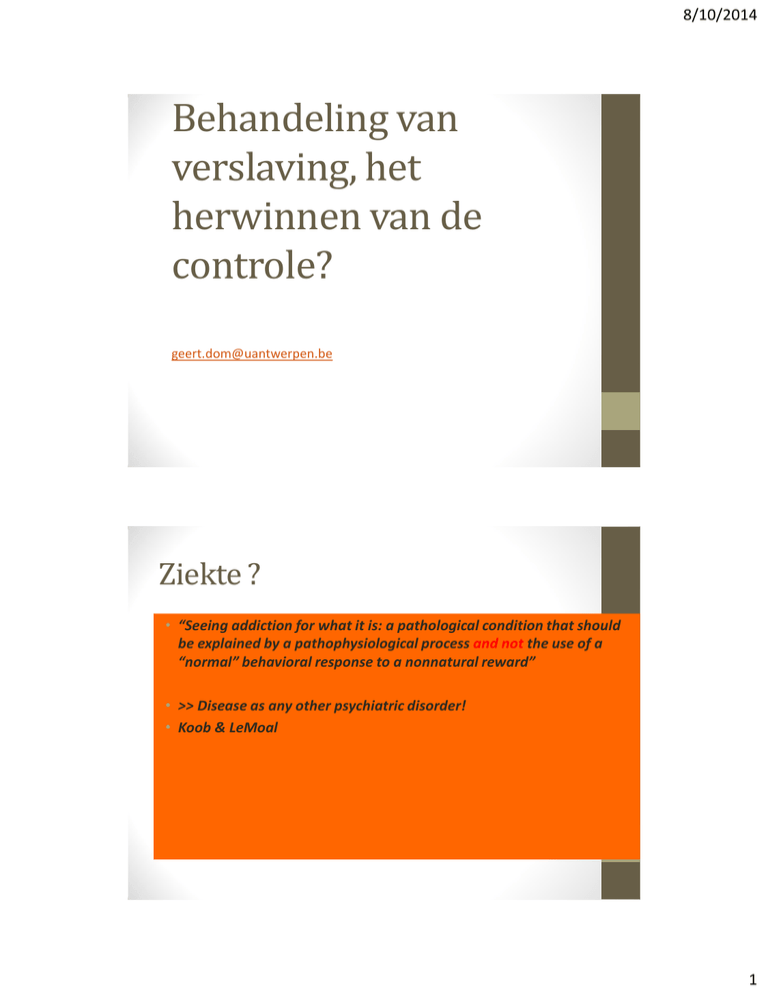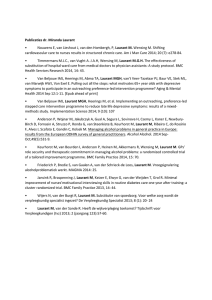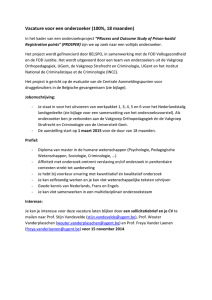Behandeling van verslaving, het herwinnen van de
advertisement

8/10/2014 Behandeling van verslaving, het herwinnen van de controle? geert.dom@uantwerpen.be Ziekte ? • “Seeing addiction for what it is: a pathological condition that should be explained by a pathophysiological process and not the use of a “normal” behavioral response to a nonnatural reward” • >> Disease as any other psychiatric disorder! • Koob & LeMoal 1 8/10/2014 Ik ben vermoedelijk een beetje pessimistisch over de neurowetenschappen… Model van het begin van verslavingsgedrag (Wiers et al., 2006) Vermogen te stoppen / Heroriënteren/ Switchen Gecontroleerde processen « Cool & slow » Motivatie om te reguleren Emotie Regulatie Automatische processen « hot & fast » Alcohol – drugs als emotionele stimulus « approach » Actie tendens Alcohol of Drug gebruik sensitizatie Alcohol / drugs Sociale context 2 8/10/2014 Model van de aanpassingen in automatische en gecontrolleerde processen bij verder gevorderd verslavingsgedrag (Wiers et al., 2006) Vermogen te stoppen / Heroriënteren/ Switchen Gecontroleerde processen « Cool & slow » Motivatie om te reguleren Emotie Regulatie Negatieve ervaringen Alcohol/drug Automatische processen « hot & fast » Alcohol – drugs als emotionele stimulus « approach » Actie tendens Alcohol of Drug gebruik sensitizatie Alcohol / drugs Sociale context Geassocieerde stimuli Verslaving 19-5-2010 Functioneel Model en Hersenstructuren 6 Volkow, 2006 3 8/10/2014 Piazza & DerocheGamonet, 2013, A multistep generl theory of transition to addiction. 4 8/10/2014 Mens en dier • Ongeveer 90% kan leren drugs te gebruiken • Transitie naar regelmatig gebruik bij een behoorlijk % spreiding harmonisch- waarbij sterk beïnvloedbaar door beschikbaarheid en regelmaat gebruik. • Slechts 17% gaat naar stadium Controle verlies en uitgesproken verslaving. Samenvatting (dieren) experimenteel onderzoek (Piazza et al., 2013) • “full addiction is not a purely human phenomenon but also exists in laboratorium rats” • Despite the use of a large amount of drug over a prolonged period, most individuals are resistent to addiction • Individual vulnerabilities seem to be a nescessary condition • Independent, different, vulnerabilities play a role in both risk transition to sustained drug use (e.g. Locomotor recation to stress, anxiety-like behavior, impulsivity) and transition to loss of control. 5 8/10/2014 Impulsiviteit: Intolerance Delay Reward (DDT) “Impuls” gebruik Reward/Ris k evaluation (IGT, CGT) Regelmatig gebruik Impulsiviteit: - Behavioral Disinhibition - Impuls control Controle verlies 1. Sensitisatie DA systemen 2. Increase GR activation >> sensitisatie DA systeem Nac 3. 1 + 2 = “Desire” 4. Hedonic set-point = “Need” Transitie naar echt controle verlies nog weinig onderzocht ! 6 8/10/2014 Synaptic plasticity • Long-term potentiation (LTP) & Depression (LTD) • “Represents the ability of the brain to strengthen or depress neuronal circuits in order to maintain adaptive behavior responses to changes in environmental contingencies (Nieman & Loewenstein, 2013)” Plasticity and Loss of Control • “The only biological modification yet specifically associated with loss of control of drug intake is a loss of synaptic plasticity (Kasanetz et al., 2010, 2012)”. • Piazza et al.; • After 18 days of cocaine use (before addiction-like behavior) a loss of NMDA-dependent LTD in the Nac of all self-administrating animals. • Later, after 60 days, return to normal LTD in those animals (majority) that remained control over intake, while animals with LoC addiction like behaviors continued impaired NMDA and GluR2/3-dependent LTD in Nac & PFC. • Vulnerability for addiction can be conceptualized as a degree of “anaplasticity”, the inability to recover a lost function. • Addicted animals (humans) remain “frozen” in a behavioral repertoire although the reward contingencies have changed dramatically. • “Imprisoned - Frozen in the behavior” 7 8/10/2014 Model van de aanpassingen in automatische en gecontrolleerde processen bij verder gevorderd verslavingsgedrag (Wiers et al., 2006) Vermogen te stoppen / Heroriënteren/ Switchen Gecontroleerde processen « Cool & slow » Motivatie om te reguleren Emotie Regulatie Negatieve ervaringen Alcohol/drug Automatische processen « hot & fast » Alcohol – drugs als emotionele stimulus « approach » Actie tendens Alcohol of Drug gebruik sensitizatie Alcohol / drugs Sociale context Geassocieerde stimuli 8 8/10/2014 Maar weten we er nu eigenlijk echt wel iets van ? 9 8/10/2014 Middel Jaarprevalentie gebruikers Jaarprevalentie verslaafden Verslavingszorg Verslaafden in huisartsenpraktijk Aantal 12+ %18+ Aantal 18+ Aantal % van ver-slaafden Per 2500 Per 150 Tabak 34 4.400.000 17 2.000.000 Nihil Nihil 425 25 Alcohol 73 9.800.000 3,7 280.000 28.000 10 90 6 Benzodiazepinen 4 500.000 3,3 250.000 Nihil Nihil 80 Cannabis 3 400.000 0,5 35.000 3.500 9 10 XTC 0,3 65.000 ? ? < 300 ? ? ? Heroïne 0,2 28.000 0,3 25.000 17.500 70 5-10 <1 Cocaïne > 0,4 > 50.000 > 0,3 > 20.000 7.000 < 30 > 10 1 Verslaving 19-5-2010 % 12+ 5 <1 19 A spectrum of responses to alcohol problems None Hazardous drinking Harmful drinking Moderately dependent drinking Reduced risk drinking Severely dependent drinking Abstinence More intensive specialist treatment Less-intensive treatment in generalist or specialist settings Extended brief interventions in generalist settings Simple brief interventions in generalist settings Public health programmes – primary preventions Rastrick et al. 2006; Adapted from Institute of Medicine. 1990 10 8/10/2014 Bias ! • Beeldvorming bij de onderzoeker, clinicus en publiek wordt bepaald door de, kleine, groep van chronische patiënten. • Op basis daarvan extrapoleren ze opinies over “verslaving” ! • >> The “Clinician’s Illusion” Cohen & Cohen, 1984, Arch Gen Psych. • In realiteit lijken mensen er best wel in te slagen hun verslaving, “psychiatrische ziekte” onder controle te houden! Van welke psychiatrische aandoening wordt de prevalentie en schade zo door de omgeving bepaald? 1960 2014 80% 23 % 11 8/10/2014 Addiction: Quitting is the rule not the exception ! • ECA study (1980s): n = 19.000. Among those who had become dependent on drugs at age 24, more than half later reported not a single drug-related symptom. By age 37, roughly 75% reported no drug symptom. • NCS & NESARC (N = 43.000) 77% & 86 % reported no more substance problems one year before survey. • !those who did report more likely to have psychiatric comorbidity. • !Relapse rates of treated drug-addicted patients 40-60%. = the chronic-relapsing patients. N = 42.000 US GP 16% van de mensen met een current afhankelijkheidsdiagnose was in behandeling (zelfhulp /professioneel) De overgrote meerderheid van de mensen stopt zonder enige vorm van hulpverlening 12 8/10/2014 Cantin et al., 2011 • Virtually all rats preferred saccharin over intravenous cocaine. • The preference for saccharin sweet taste was not surmountable by increasing doses of cocaine and was observed despite either cocaine intoxication, sensitization or intake escalation – the latter being a hallmark of drug addiction. • In addition, in several cases (85%), the preference for saccharin emerged in rats which had originally developed a strong preference for the cocainerewarded lever. • Such reversals of preference clearly show that in our setting, animals are not stuck with their initial preferences and can change them according to new reward contingencies. • Finally, the preference for saccharin was maintained in the face of increasing reward price or cost, suggesting that rats did not only prefer saccharin over cocaine (‘liking’) but they were also more willing to work for it than for cocaine (‘wanting’). Factoren die een rol spelen bij stoppen (of “uit de diagnose vallen”) • Afwezigheid psychiatrische en medische co-morbiditeit. • • • • • • • Relationele status (gehuwd > single) Economische druk Angst juridische consequenties Bezorgd over respect verlies bij kinderen en familie Hoger inkomen Opleidingsniveau “mensen met verslavingsproblemen geven vaak aan dat ze stopten met gebruik om een betere ouder te zijn, familie trots te maken, en geen schaamtevolle dingen meer te willen doen” • >> Drijfveren om te stoppen zijn dus voornamelijk de praktische en morele bezwaren die een rol spelen bij majeure beslissingen/keuzes. • <> heel andere drijfveren dan die een rol spelen bij andere medische (brein) aandoeningen: Alzheimer – Schizofrenie – diabetes – • Het ene voordeel vervangen door een ander beter ! 13 8/10/2014 Dubbel Diagnose Verandering omgevingscontingenties Spirituele morele incentives Zelfcontrole technieken 14 8/10/2014 Huidige vormen van behandeling farmacotherapie Psychosociaal: zelfhulp Behandeling alcohol Medications for Relapse Prevention Addicted Brain Non-Addicted Brain Interfere with drug’s reinforcing effects Vaccines Enzymatic degredation Naltrexone DA D3 antagonists CB1 antagonists Executive function/ Inhibitory control Biofeedback Modafinil Bupropion Stimulants Control Control Saliency Saliency prefrontalGO Strengthen STOP striatal communication Drive Drive Memory Memory Adenosine A2 antagonists DA D3 antagonists Interfere with conditioned memories (craving) Antiepileptic GVG N-acetylcysteine Teach new memories Cycloserine Counteract stress responses CRF antagonists that lead to relapse Orexin antagonists 15 8/10/2014 Model van de aanpassingen in automatische en gecontrolleerde processen bij verder gevorderd verslavingsgedrag (Wiers et al., 2006) Vermogen te stoppen / Heroriënteren/ Switchen Gecontroleerde processen « Cool & slow » Motivatie om te reguleren Emotie Regulatie Negatieve ervaringen Alcohol/drug Automatische processen « hot & fast » Alcohol – drugs als emotionele stimulus « approach » Actie tendens Alcohol of Drug gebruik sensitizatie Alcohol / drugs Sociale context Geassocieerde stimuli 16 8/10/2014 Improving impulse control could be an important target for treating alcohol dependence. Aanpakken hedonische dysregulatie 17 8/10/2014 HDD/TAC: change from baseline in the 1-year study: Patients with at least high DRL at baseline and randomisation Herwinnen controle maar dan moet patiënt de pil wel nemen !! SENSE: change in HDDs SENSE: change in TAC 19 HDDs 100 g/day Difference: -3.6 HDDs, p=0.0164 7 HDDs MMRM (OC) FAS estimates and SE; *p<0.05; MMRM=mixed-effect model repeated measure; OC=observed cases; FAS=full analysis set; SE=standard error Difference: -17.3 g/day, p=0.0129 33 g/day van den Brink et al. SENSE. Poster at EPA 2013 van den Brink et al. J Psychopharmacol, in press Summary of effect sizes. Leucht S et al. BJP 2012;200:97-106 ©2012 by The Royal College of Psychiatrists 18 8/10/2014 19 8/10/2014 Laag frequente rTMS = blokkerend 20 8/10/2014 Diepe Brein Stimulatie geschiedenis • Sinds jaren 1990 vooral Parkinson • Gemerkt dat verslavingsgedrag bij Parkinson pat. Veranderd • Vanaf 2005 ook psychiatrische indicaties (OCD) • Case series Bechara & insula infarct. • Momenteel +/- 4 studies specifiek op verslaving. ©2012 by Cleveland Clinic DHS bij alcohol afhankelijkheid N=6 • Vier jaar opvolging • Vermindering craving • 2 van de 6 patienten bleven abstinent gedurende de volledige opvolgingsduur. 21 8/10/2014 Future Research Immunotherapies for Addiction Treatment (i.e., Vaccines) Antibodies Can Reduce Brain Concentrations VACCINE Binding Site Antibodies Capillary Blood Flow Brain Targeting the drugs, not the receptors Capillary Blood Flow Brain 22 8/10/2014 (met Mike Rinck, RUN e.a.) 46 23 8/10/2014 Klinische Re-training (Schoenmakers et al. ) 37 alcoholisten: 4 x trainen in alcohol-kliniek (Attentional Retraining of placebo-training). * Effecten op Attentional Bias + voorzichtige indicaties Klinische effecten (minder Terugval; kortere succesvolle behandelduur 47 • http://mindsurfer.eu/jasmin_demo2/demos/cbm/config.html 24 8/10/2014 Cognitive online training ? Model van de aanpassingen in automatische en gecontrolleerde processen bij verder gevorderd verslavingsgedrag (Wiers et al., 2006) Vermogen te stoppen / Heroriënteren/ Switchen Gecontroleerde processen « Cool & slow » Motivatie om te reguleren Emotie Regulatie Negatieve ervaringen Alcohol/drug Automatische processen « hot & fast » Alcohol – drugs als emotionele stimulus « approach » Actie tendens Alcohol of Drug gebruik sensitizatie Alcohol / drugs Sociale context Geassocieerde stimuli 25 8/10/2014 Improving impulse control could be an important target for treating alcohol dependence. Versterken van de ruiter ! 26 8/10/2014 rTMS • rTMS: Repetitieve transcraniele magnetische stimulatie (Hoog frequent = stimulerend). • rDCS: Direct Current Stimulation (Hoog & laag frequent) Hoog frequente rTMS = activerend 27 8/10/2014 Transcraniele Magnetische Stimulatie bij Cocaineverslaafden Een is misschien te weinig…….. 28 8/10/2014 Kan men craving “reguleren”? DCRAVING CRAVING INDUCTION IN A PET SETTING 5 4 3 2 1 0 -1 N = 13 Neutral Cocaine Conditioned Association STIMULI 2.5 2.0 1.5 1.0 .5 0 Nature Video Cocaine Video Childress et al., Am. J. Psychiatry, 1999 29 8/10/2014 N.D. Volkow et al. / NeuroImage 49 (2010) 2536–2543 mOFC NAcc 30 8/10/2014 Versterken van de ruiter ! Goal management training 31 8/10/2014 Alfonso et al., 2011 32 8/10/2014 Alfonso et al., 2011 TRAINING Polysubstance abusers Improvement executive cognitive functioning ? Substance use outcome ? Mindfulnes based JAMA Psychiatry. 2014 May;71(5):547-56. 33 8/10/2014 Bowen et al., 2014 TAU = 12-step 28-day inpatient 8-weeks after care RP (= CBT) 3/6/12 m. follow up 90-day intensive outpatient RPMB Bowen et al., 2014. • For individuals in aftercare following initial treatment for substance use disorders, RP and MBRP, compared with TAU, produced significantly reduced relapse risk to drug use and heavy drinking. • Relapse prevention delayed time to first drug use at 6-month followup, with MBRP and RP participants who used alcohol also reporting significantly fewer heavy drinking days compared with TAU participants. • At 12-month follow-up, MBRP offered added benefit over RP and TAU in reducing drug use and heavy drinking. • Targeted mindfulness practicesmay support long-term outcomes by strengthening the ability to monitor and skillfully cope with discomfort associated with craving or negative affect, thus supporting long-term outcomes. 34 8/10/2014 Improving impulse control could be an important target for treating alcohol dependence. 35 8/10/2014 Versterken van de ruiter ! HET VERSTERKEN VAN COGNITIEVE ZELFCONTROLE MET MODAFINIL EN DE RELATIE TOT HERVAL BIJ ALCOHOLAFHANKELIJKE PATIENTEN 36 8/10/2014 Alleen bij patiënten met slechte baseline inhibitie 37 8/10/2014 Schmaal et al. 2014 Psycholog Medic 38 8/10/2014 Method: protocol Inclusion Baseline Week 0 Follow-up (FU) Interview by phone Treatment Modafinil/Placebo – 10 weeks 1 2 3 4 5 6 7 8 9 10 3 months Screenin g and baseline Testing during treatmen t Testing after treatmen t T0 T1 T2 6 months FU1 FU2 Results: Complete abstinence Groups did not significantly differed in abstinence rates • Abstinence rates 60 X²: p=.416 Percentage abstinence 50 40 X²: p=.214 30 Modafinil Placebo 20 10 0 End of treatment (10 weeks) End of follow-up (6 months) 39 8/10/2014 Results: Primary outcome measures Modafinil improved self-reported state impulsivity • Primary outcome measures: MMRM: Time by treatment: p=.001 Modafinil Placebo 45 Total STIMP scores • Alcohol use • % abstinent days (T ) • % heavy drinking days (T ) • Impulsivity • Self-reported state impulsivity • Response inhibition (SST) (T ) • Delay discounting (DDT) 40 35 30 25 T0 T1 Time T2 Results: mediation analyses Redundant Modafinil treatment X Alcohol use Changes in impulsive behaviour 40 8/10/2014 Bi-directional effects in subgroups Percentage Abstinent Days (MMRM 3-way: p<.001) Good Response Inhibition (n=41) Placebo Modafinil 100 100 90 90 80 80 % Abstinent Days % Abstinent Days Modafinil Poor Response Inhibition (n=42) 70 60 50 Placebo 70 60 50 40 40 T2 FU1 FU2 T2 FU1 Time FU2 Time MMRM: time by treatment: p=.002 MMRM: time by treatment: p=.066 Bi-directional effects in subgroups Percentage Heavy Drinking Days (MMRM 3-way: p=.001) Good Response Inhibition (n=41) Placebo Modafinil 45 45 40 40 35 35 % Heavy Drinking Days % Heavy Drinking Days Modafinil Poor Response Inhibition (n=42) 30 25 20 15 30 25 20 15 10 10 5 5 0 Placebo 0 T2 FU1 FU2 Time MMRM: time by treatment: p=.003 T2 FU1 FU2 Time MMRM: time by treatment: p=.656 41 8/10/2014 Combinatie therapieen ? • Werken op ruiter & paard Therapie x medicatie • Werken op twee systemen; bv. Craving x zelfcontrole: • rTMS x nalmefene/campral/naltrexon: ?? • CBT x naltrexone: COMBINE studie (Compliance bij patiënten met psychiatrische co-morbiditeit) • BRENDA x Nalmefene: compliance • Of proberen een systeem dubbel te beïnvloeden: • CBT x modafinil 42 8/10/2014 Gilleen et al., 2014 • Rate of new-language learning was significantly enhanced with modafinil, and effects were greatest over the first five sessions. Modafinil improved within-day learning rather than between-day retention. • No enhancement of gains with modafinil was observed in working memory nor rate of verbal learning. Gains in all tasks were retained post drug administration, but transfer effects to broad cognitive abilities were not seen. • ?? 43 8/10/2014 Verandering omgevingscontingenties Spirituele morele incentives Zelfcontrole technieken Verandering omgevingscontingenties Spirituele morele incentives Zelfcontrole technieken 44 8/10/2014 45 8/10/2014 And….. • Participants who received the contingency management intervention were 2.4 times as likely as those in the control condition to submit a stimulant-negative urine sample during treatment • The cost of urine testing and reinforcers was $256 per participant for the entire treatment group ($864 for individuals with $8 weeks of abstinence). • individuals assigned to the contingency management condition experienced 138 fewer days of psychiatric hospitalization than those in the control condition. • Our data suggest that an effect of contingency manage- ment on stimulant abstinence persisted after treatment was discontinued. Besluit • Groot deel van de mensen met verslavingsproblemen herwinnen op eigen kracht de controle over hun gebruik. • Ongekend terrein waar we nog veel van kunnen leren. • Een klein deel “zwaar verslaafden “ meestal met psychiatrische comorbiditeit beantwoord aan het chronisch (brein) ziekte model. • Werken aan zelfcontrole is werken aan zowel het drive deel (paard) als het controle (ruiter). • Individuele matching (profilering) staat nog in kinderschoenen. • Combinatie therapieën gericht op beide dimensies onderzoek naar de toekomst. • Veranderen van omgevingscontingenties en stress management… 46 8/10/2014 Pieter Bruegel 47

